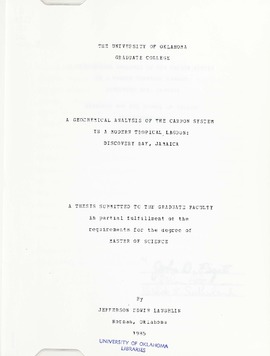| dc.contributor.author | Laughlin, Jefferson Edwin | |
| dc.date.accessioned | 2017-02-20T23:38:45Z | |
| dc.date.available | 2017-02-20T23:38:45Z | |
| dc.date.issued | 1985 | |
| dc.identifier.uri | https://hdl.handle.net/11244/48336 | |
| dc.description.abstract | "The factors which alter the total CO2 content of waters residing in Discovery Bay, Jamaica include photosynthesis, respiration, precipitation, dissolution, groundwater invasion, aerobic decay of organic matter, and gas exchange across the air-sea interface. Groundwater invasion of O2-charged meteoric waters can be accounted for by monitoring alkalinity and pH decreases associated with decreases in chlorinity. Disregarding the changes in alkalinity resulting from dilution, alkalinity changes represent the effects of precipitation and dissolution. Diurnal oxygen variations are used to estimate the organic metabolism and oxidation reactions occurring within the bay. The changes in total CO2 resulting from gas exchange can be determined by subtracting the total CO2 changes resulting from productivity, precipitation-dissolution, and groundwater invasion from the observed total CO2 changes. | |
| dc.description.abstract | Based on the assumptions of a closed system and that the aforementioned factors fully define the pathways of CO2 fluxes, several conclusions can be drawn regarding Discovery Bay. Both photosynthesis-respiration and dissolution-precipitation processes are linked to invasion-evasion, yet show no apparent link to each other. (Abstract shortened by UMI.)" | |
| dc.language | en_US | |
| dc.subject | Chemical oceanography | |
| dc.subject | Seawater--Carbon dioxide content | |
| dc.subject | Lagoons--Jamaica | |
| dc.title | A Geochemical Analysis Of The Carbon System In A Modern Tpopical Lagoon: Discovery Bay, Jamaica | |
| dc.type | Thesis | |
| dc.date.manuscript | 1985 | |
| dc.thesis.degree | Master of Science | |
| ou.group | Geology and Geophysics, School of | |
